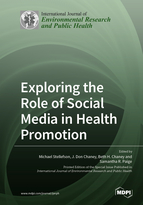Exploring the Role of Social Media in Health Promotion
A special issue of International Journal of Environmental Research and Public Health (ISSN 1660-4601). This special issue belongs to the section "Digital Health".
Deadline for manuscript submissions: closed (31 December 2019) | Viewed by 124494
Special Issue Editors
Interests: web-based patient education; evaluation of interactive health communication tools; chronic disease self-management; assessment of electronic health (eHealth) literacy
Interests: distance education; educational technologies in health education/promotion
Interests: measurement; evaluation of community-based research; social media in health promotion and disease management; alcohol use and misuse among college student populations
Interests: tobacco-associated lung disease care continuum; computer-mediated communication; cognitive and affective message processing; measurement
Special Issues, Collections and Topics in MDPI journals
Special Issue Information
Dear Colleagues,
The use of social media in public health education/promotion has been increasing due, in part, to its ability to remove physical access and geographical barriers for users. Specifically, social media provide an outlet to increase and promote translational health communication strategies and effective dissemination of health information and data in ways that allow users to not only utilize, but also create and share pertinent health information. Although social media applications in public health and health promotion have yielded success in terms of generating support structures and networks for effective health behavior change, there are challenges and complications associated with use of social media that also need to be addressed (e.g., managing misinformation, ensuring compliance with privacy protections). This Special Issue aims to explore social media as a translational health promotion tool by bridging principles of health education and health communication. Broadly, this Special Issue is seeking original submissions that examine: (1) The method with which social media users access, negotiate, and create health information that is both actionable and impactful for diverse audiences; (2) strategies for overcoming challenges to using social media in health promotion; and (3) best practices for designing, implementing, and/or evaluating social media campaigns and forums in public health. Special interest will be given to innovative submissions that expand and build upon traditional health education approaches with health communication theories and models. Other manuscript types of interest include relevant position papers, brief reports, and commentaries.
Prof. Dr. Michael Stellefson
Prof. Dr. J. Don Chaney
Prof. Dr. Beth H. Chaney
Dr. Samantha R. Paige
Guest Editors
Manuscript Submission Information
Manuscripts should be submitted online at www.mdpi.com by registering and logging in to this website. Once you are registered, click here to go to the submission form. Manuscripts can be submitted until the deadline. All submissions that pass pre-check are peer-reviewed. Accepted papers will be published continuously in the journal (as soon as accepted) and will be listed together on the special issue website. Research articles, review articles as well as short communications are invited. For planned papers, a title and short abstract (about 100 words) can be sent to the Editorial Office for announcement on this website.
Submitted manuscripts should not have been published previously, nor be under consideration for publication elsewhere (except conference proceedings papers). All manuscripts are thoroughly refereed through a single-blind peer-review process. A guide for authors and other relevant information for submission of manuscripts is available on the Instructions for Authors page. International Journal of Environmental Research and Public Health is an international peer-reviewed open access monthly journal published by MDPI.
Please visit the Instructions for Authors page before submitting a manuscript. The Article Processing Charge (APC) for publication in this open access journal is 2500 CHF (Swiss Francs). Submitted papers should be well formatted and use good English. Authors may use MDPI's English editing service prior to publication or during author revisions.
Keywords
- Social media
- Translational health communication
- Online social networking
- Health education
- Health promotion
- Participative engagement
- eHealth literacy
- Online health information-seeking behaviors
- Consumer health informatics
- Online community






